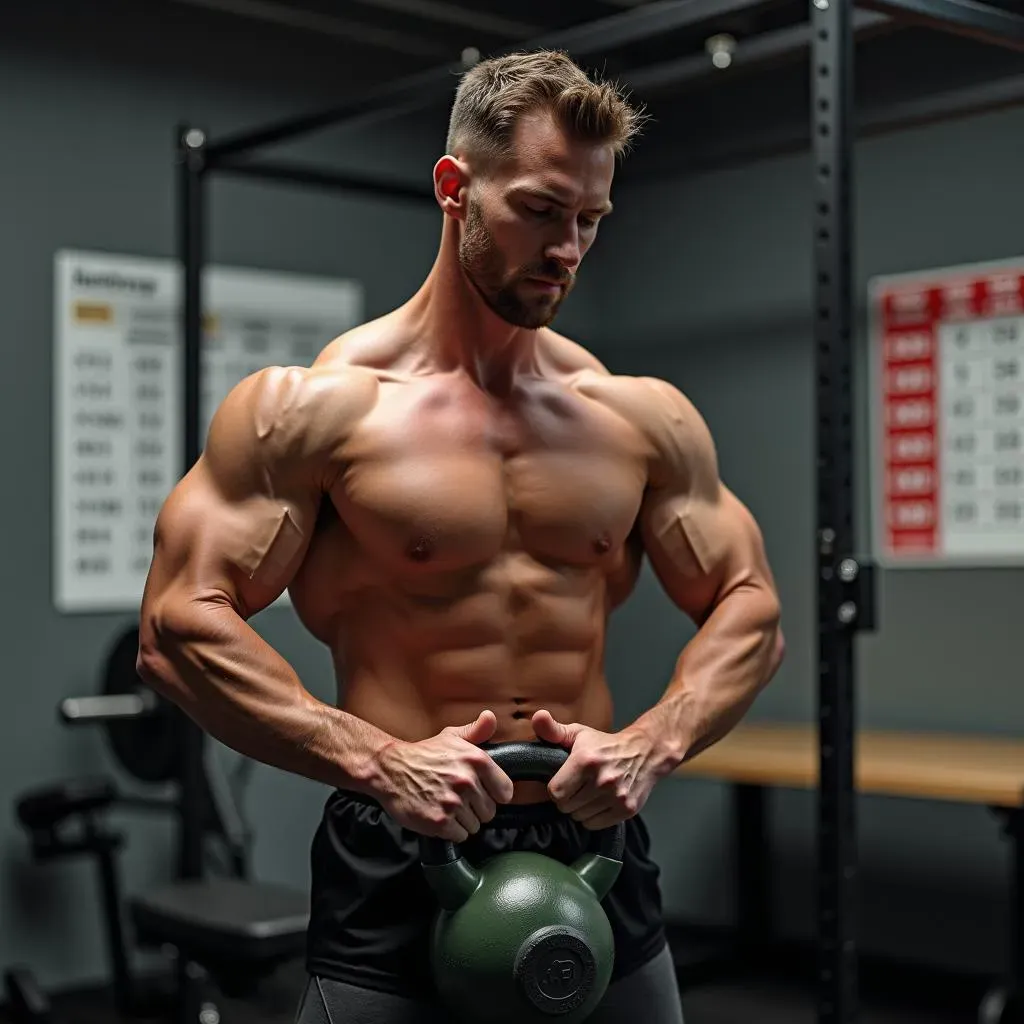Table of Contents
Want to carve out boulder shoulders? Then you've landed in the right spot. This isn't your run-of-the-mill fitness fluff; we're diving deep into the world of deltoid kettlebell exercises. Forget endless sets of lateral raises with dumbbells – kettlebells offer a unique challenge that can unlock serious shoulder strength and definition. We're talking functional fitness that translates to real-world power.
Understanding the Deltoid Muscles and Kettlebell Training

Understanding the Deltoid Muscles and Kettlebell Training
So, you're ready to dive into the world of deltoid kettlebell exercises? Awesome! But before we start swinging and pressing, let's get a handle on the basics. Your deltoids, or shoulder muscles, aren't just one big chunk of meat. They're actually made up of three distinct heads: the anterior (front), lateral (side), and posterior (rear) deltoids. Each plays a crucial role in shoulder movement and overall upper body function. The anterior deltoid helps with flexion and internal rotation, the lateral deltoid handles abduction (raising your arm to the side), and the posterior deltoid assists with extension and external rotation.
Now, why kettlebells? Unlike dumbbells, kettlebells have an offset center of gravity. This means your muscles have to work harder to control the weight, especially your stabilizer muscles. This is great for shoulder health, as it forces those little muscles around your rotator cuff to fire up and keep your shoulder joint stable. Plus, the dynamic nature of kettlebell exercises allows you to train your deltoids through a full range of motion, promoting both strength and mobility.
Think of it this way: a dumbbell is like driving an automatic car – easy and predictable. A kettlebell? That's like driving a stick shift – it requires more control, coordination, and finesse. And just like mastering a stick shift makes you a better driver, mastering kettlebell exercises will make you a better, stronger, and more injury-resistant athlete.
Effective Deltoid Kettlebell Exercises for Strength and Size

Effective Deltoid Kettlebell Exercises for Strength and Size
Alright, let's get to the good stuff: the exercises! When it comes to effective deltoid kettlebell exercises for strength and size, variety is key. You need to hit all three heads of the deltoid to build well-rounded, functional shoulders. We're not just talking about looking good in a t-shirt (though that's a nice bonus). We're talking about improving your posture, preventing injuries, and boosting your overall athletic performance.
So, what are the best exercises? Well, let's break it down by deltoid head. For the anterior deltoid, think pressing movements like kettlebell front squats and presses. For the lateral deltoid, lateral raises and upright rows are your friends. And for the posterior deltoid, focus on rowing variations and face pulls. But remember, with kettlebells, it's not just about the movement itself, it's about the control and stability you maintain throughout the exercise.
Below are some of my favorite kettlebell exercises for each of the deltoid muscles:
- Anterior Deltoid: Kettlebell Front Squats, Kettlebell Strict Press, Kettlebell Arnold Press
- Lateral Deltoid: Kettlebell Lateral Raises, Kettlebell Upright Rows, Kettlebell Cuban Press
- Posterior Deltoid: Kettlebell Rows, Kettlebell Face Pulls, Kettlebell Renegade Rows
It's important to remember that proper form is paramount when performing any exercise, especially with kettlebells. Start with a lighter weight and focus on mastering the movement before increasing the load. If you're unsure about your form, consider working with a qualified kettlebell instructor.
Crafting Your Deltoid Kettlebell Workout: Sets, Reps, and More

Crafting Your Deltoid Kettlebell Workout: Sets, Reps, and More
Finding the Right Rep Range
so you've got your exercises picked out. Now, how many reps and sets should you be doing? Well, that depends on your goals. Are you looking to build pure strength, or are you more interested in hypertrophy (muscle growth)?
For strength, you'll want to stick to lower rep ranges, like 3-5 reps per set, with heavier weights. For hypertrophy, aim for 8-12 reps per set. And if you're looking for more of a muscle endurance, you can push it up to 15-20 reps per set. Remember, these are just guidelines. Experiment and see what works best for your body.
Goal | Rep Range | Sets |
|---|---|---|
Strength | 3-5 | 3-5 |
Hypertrophy | 8-12 | 3-4 |
Endurance | 15-20 | 2-3 |
Structuring Your Workout
When designing your deltoid kettlebell workout, think about how you're going to structure it. One popular approach is to start with compound exercises, like kettlebell presses, and then move on to isolation exercises, like lateral raises. This allows you to hit your deltoids with maximum intensity while you're fresh, and then target specific heads with more focused movements.
Another option is to use a circuit training approach, where you perform a series of exercises back-to-back with minimal rest. This is a great way to get your heart rate up and burn some extra calories while you're building your shoulders. Just be sure to listen to your body and take breaks when you need them.
Maximizing Deltoid Development: Combining Kettlebells with Other Training

Maximizing Deltoid Development: Combining Kettlebells with Other Training
The Power of Synergy: Kettlebells and Compound Lifts
Alright, so you're crushing it with kettlebell exercises, but want to take your shoulder development to the next level? That's where combining kettlebells with other training modalities comes in. Think of it as creating a symphony of strength, where each instrument (or exercise type) plays its part to create a harmonious and powerful sound.
One of the best ways to maximize deltoid development is to pair kettlebell exercises with classic compound lifts like barbell overhead presses, push-ups, and rows. These exercises work multiple muscle groups at once, allowing you to lift heavier weights and build overall strength. By incorporating kettlebells, you're adding an element of instability and functional movement that these traditional lifts might lack.
Kettlebells and Calisthenics: A Match Made in Shoulder Heaven
Speaking of bodyweight exercises, kettlebells and calisthenics are a match made in shoulder heaven. Calisthenics exercises like dips and handstand push-ups are fantastic for building shoulder strength and stability, but they can be tough to scale for beginners. That's where kettlebells come in.
Kettlebell exercises like the Turkish get-up can help you build the core strength and shoulder stability you need to progress to more advanced calisthenics movements. Plus, the dynamic nature of kettlebell exercises can improve your mobility and coordination, making you a more well-rounded athlete.
Exercise | Benefits | How to Combine |
|---|---|---|
Barbell Overhead Press | Builds overall shoulder strength | Use kettlebell clean and press as a warm-up |
Dips | Develops chest and shoulder strength | Incorporate kettlebell dips for added challenge |
Handstand Push-ups | Advanced shoulder strength and stability | Use kettlebell Turkish Get-Ups to build stability |
Don't Forget the Little Guys: Accessory Work for Deltoid Health
While compound lifts and dynamic kettlebell exercises are essential for building overall shoulder strength and size, don't forget about the little guys: the rotator cuff muscles. These small muscles play a crucial role in shoulder stability and injury prevention.
Incorporating accessory work like face pulls, external rotations, and scapular retractions can help strengthen these muscles and keep your shoulders healthy and happy. You can use resistance bands, light dumbbells, or even kettlebells to perform these exercises. Just be sure to focus on proper form and control. Remember, a strong and healthy shoulder is a happy shoulder!
Conclusion: Kettlebells for Deltoids – A Powerful Partnership
Integrating deltoid kettlebell exercises into your training regimen offers a dynamic and effective approach to shoulder development. From building raw strength and power to enhancing stability and mobility, kettlebells provide a unique stimulus that traditional dumbbell exercises often miss. By understanding the anatomy of your deltoids and strategically selecting the right kettlebell movements, you can unlock new levels of shoulder performance and aesthetics. So, grab a kettlebell, dial in your form, and start sculpting those delts. Your shoulders will thank you for it.